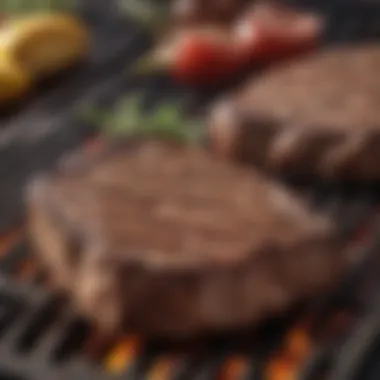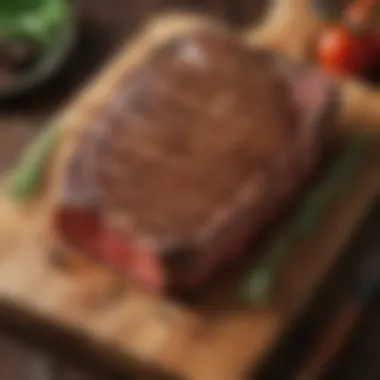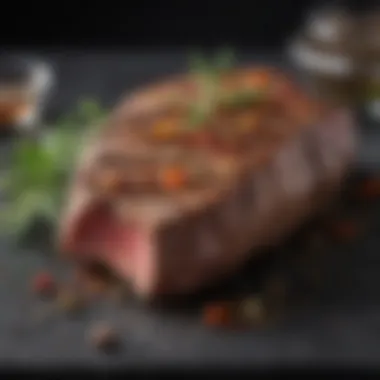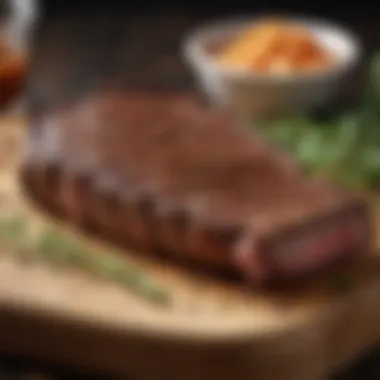Mastering the Art of Grilling Steak for Perfection


Intro
Grilling steak can often feel like an art and a science rolled into one, appealing to both the novice and the seasoned grill master. Whether you find yourself at a backyard barbecue or preparing a quiet dinner, knowing how to grill steak properly can set the tone for any meal. The juiciness of a well-cooked steak, paired with the right seasoning, can transform an ordinary evening into a remarkable experience.
However, not all steaks are created equal. Understanding the science behind temperature control, the selection of cuts, and the nuances of seasoning and resting are key components in this flavorful equation. This guide looks at various methods and practical tips that anyone can implement.
In this piece, we will delve into the details that make a difference—highlighting crucial points while emphasizing the relevance of mastering the grill. It’s not just throwing a piece of meat on the flames; it’s about the journey from selection to savoring.
As we navigate this grilling landscape, you'll discover that achieving culinary excellence in steak preparation is not reserved solely for those with culinary degrees. Instead, every food lover, regardless of their cooking background, can refine their skills and elevate their grilling game.
Understanding Steak Cuts
Selecting the right cut of steak is fundamental for any grilling endeavor. It's the heart of the culinary experience and can significantly impact the flavor, tenderness, and overall enjoyment of the meal. Different cuts come from various parts of the cow, yielding distinct textures and taste profiles. Knowing the characteristics of each cut enables the cook to make informed decisions, ensuring that every steak grilled is an exquisite delight.
Popular Cuts for Grilling
When it comes to grilling, some cuts stand out above the rest. Their attributes and qualities make them not just good options, but great ones.
Ribeye
Ribeye is often hailed as one of the best cuts for grilling, and for good reason. This cut is rich in fat marbling, which translates to more flavor and a juicier bite. The marbling is what sets ribeye apart; it melts as the steak cooks, providing an incomparable richness.
But let’s not kid ourselves: ribeye is not just about flavor—it’s about satisfaction. When perfectly grilled, it creates a crisp exterior while remaining tender and flavorful on the inside. The drawback might be that it can be a bit pricier compared to other cuts, but for many, the taste is worth the investment.
Sirloin
Sirloin offers a delicious balance of flavor and tenderness, making it popular among grilling enthusiasts. This cut is often seen as leaner than ribeye, though it still retains a good amount of beefy flavor. One of the advantages of sirloin is its versatility; it can easily be seasoned in numerous ways or marinated to suit various taste preferences.
However, with less fat compared to ribeye, there's a risk of overcooking it, resulting in a tougher steak. A watchful eye can serve you well here.
T-bone
T-bone steaks are a true gem on the grill. Comprising two distinct cuts—the strip and the tenderloin—this steak caters to different taste preferences in each bite. The bone in the middle also helps in imparting flavor during cooking.
The appeal of T-bone lies in that satisfying contrast – you get the tenderness of the filet mignon with the robust flavor of the strip. On the downside, the T-bone can be challenging to grill evenly due to its size and thickness, requiring careful management of grill zones.
Filet Mignon
Filet mignon represents luxury on a plate. Known for its incredible tenderness, this cut comes from the tenderloin, which does very little work, resulting in a buttery texture that melts in your mouth. For special occasions, filet mignon shines, often taking center stage on the grill.
Yet, while its tenderness is unrivaled, it often lacks the robust flavor found in fattier cuts like ribeye or T-bone. Some chefs prefer to enhance its flavor through marinades or toppings, ensuring it doesn't fall flat amid its exquisite texture.
Choosing Quality Meat
The quality of the meat is paramount to achieving that perfect steak on the grill. Quality varies significantly, and recognizing these differences can elevate the grilling experience—a small misstep here could lead to disappointment on your plate.
Grades of Beef
Beef grades are crucial indicators of quality, with classifications such as Prime, Choice, and Select marking differences in tenderness and flavor. Generally, Prime cuts offer superior marbling and are often found in high-end restaurants. Choice is a great value, striking an excellent balance between quality and cost. Select is leaner, which might fit some health-conscious diets, but may lack the flavor some associate with a standout steak.
Marbling Explained
Marbling refers to the fat content interspersed within the muscle of the meat. This feature is usually what leads to tenderness and moistness. More marbling often means the steak will be richer and more flavorful. While some steer away from fat for dietary reasons, this intrinsic quality plays a pivotal role in the overall grilling experience—too little marbling can leave the cut dry with a flat taste.
Grass-fed vs. Grain-fed
Grass-fed beef tends to be leaner and often comes with a more pronounced, earthy flavor. It’s often regarded as a healthier option due to the cow’s natural diet. On the flip side, grain-fed beef generally provides a more buttery taste and a higher level of marbling. Choosing between these options boils down not only to flavor preferences but also to considerations regarding health, sustainability, and ethical concerns.
Remember, the cut of meat you choose can make or break your grilling experience. Invest a little extra time in understanding the available options, and your taste buds will thank you.
Preparing for the Grill
The journey to achieving a perfectly grilled steak starts long before the meat hits the heat. Preparing for the grill is not just a matter of lighting the fire; it involves understanding the tools, equipment, and techniques that elevate your cooking game to new heights. Every seasoned grill master knows the importance of being well-prepared, as this can significantly impact the flavor and texture of the steak.
Setting up for your grilling endeavor encompasses not just the physical preparations but also an awareness of what creates a successful grilling experience. Being organized and informed can save you from last-minute stress, turning the process into a more enjoyable and rewarding one.
Essential Tools for Grilling


Grill Types: Charcoal vs. Gas
When it comes to grilling, choosing the right type of grill is essential. Charcoal and gas grills each hold their unique charm and offer different cooking experiences. Charcoal grills, often favored for their ability to impart a smoky flavor that many enthusiasts adore, require a bit of patience and skill to maintain the ideal temperature. On the other hand, gas grills boast the convenience of instant heat and adjustable control, making them a popular choice for weeknight cookouts.
A charcoal grill can certainly be more labor-intensive for some, yet many believe that the flavor achieved from charcoal is irreplaceable. The crackle of charcoal as it ignites and the aroma it produces can bring a sense of nostalgia that many enjoy. However, using a gas grill can be a more straightforward process, allowing for quick clean-up and less hassle overall. As you explore your options, consider what experience you seek and how much time and energy you wish to invest in the preparation.
Thermometers
A good thermometer might just be the unsung hero of grilling. The importance of accurately measuring the internal temperature of the steak cannot be overstated. Overcooking a steak not only diminishes its natural juices but also negatively influences flavor and tenderness. The right thermometer can save the day—especially when entertaining or cooking for guests.
There are several types of thermometers available, from instant-read digital ones to probe thermometers that can remain in the meat while it cooks. Each comes with its advantages. Instant-read thermometers provide quick feedback, while probe thermometers allow for longer cook times without constant monitoring. Whichever you choose, ensure that it’s properly calibrated to get the accurate readings necessary for achieving that perfect doneness.
Utensils and Accessories
The right utensils and accessories can make all the difference in your grilling experience. Tongs, spatulas, and basting brushes are fundamental tools that every grill master should have in their kit. Tongs, especially, allow for easy flipping without losing precious juices, while a sturdy spatula can help in managing thicker cuts without breaking apart.
Moreover, a good grill brush for cleaning is essential for maintaining your grill's surface. Many overlook this aspect, yet a clean grill not only promotes health but also ensures that flavors from previous cookouts don't interfere with your current creation. While simple in concept, having the right tools can enhance both efficiency and safety while grilling.
Marinades and Seasonings
Simple Seasoning Techniques
Before searing, a good steak just begs for the right touch of seasoning. Sometimes, simplicity holds the key to making flavors shine. A generous sprinkling of kosher salt and freshly cracked pepper can elevate the meat by enhancing its natural flavors rather than overshadowing them.
These basic seasoning principles help maintain the integrity of the steak. Understanding how salt interacts with the meat—drawing out moisture and creating that glorious crust—underscores its significance. Remember, sometimes less is more, especially when allowing the steaks' quality to shine.
Herb and Spice Combinations
Venturing into the world of herb and spice combinations can add complexity to your grilled steak. Whether it’s a zesty chimichurri or a simple garlic and rosemary rub, the right mix can elevate the dish from ordinary to extraordinary. Fresh herbs bring brightness and depth, drawing contrast to the richness of the meat.
Cilantro, rosemary, and thyme can create a fragrant layer that complements without overwhelming. Choosing the right combination can depend on the steak cut and the overall flavor profile you desire.
Timeframe for Marinades
Timing is everything when it comes to marinades. While marinating can infuse flavors and tenderness, leaving a steak in marinade too long can lead to a mushy texture. A general rule of thumb is to allow the meat to marinate for a minimum of 30 minutes but no more than 24 hours; this time frame helps achieve that perfect balance without compromising the meat's natural texture.
By preparing your ingredients ahead of time and understanding the powers of marinade, you're setting yourself up for success. A well-prepped steak can easily be the talk of any gathering.
Mastering the Grilling Process
Grilling steak is an art that hinges not only on selecting the right cut and seasoning but heavily on mastering the grilling process itself. Accurately controlling the heat and understanding various techniques can dramatically influence the outcome of your steak.
This section serves to highlight the pivotal elements of setting up the grill and applying precise grilling techniques. These components are essential in shaping the final taste and texture of your meat. When executed correctly, you will be well on your way to creating a steak that’s tender and bursting with flavor.
Setting Up the Grill
Direct vs. Indirect Heat
Understanding direct and indirect heat is crucial when grilling steak. Direct heat involves placing the steak directly over the flame, delivering high temperatures quickly, which is perfect for achieving a nice crust. Indirect heat means placing the meat away from the flame, allowing for a slower, gentler cooking process. This method is beneficial for larger cuts that require a longer cooking time without burning.
The key characteristic of direct heat is its ability to caramelize the exterior, creating that sought-after crust, while indirect heat allows the inside to reach the desired doneness without overcooking the surface. Each method has its place, depending on what you're aiming for. For instance, if you want a crispy exterior on a ribeye, then you might start with direct heat followed by the indirect method for finishing it off.
This dance between heat types is not just a cooking style; it’s the heartbeat of a great grill session.
Preheating Techniques
Preheating is all about preparing your grill for the task at hand. Many overlook its importance, but a well-preheated grill ensures more consistent cooking and helps prevent sticking. The characteristic here is the temperature uniformity that comes once the grill is ready; you want that heat spread evenly.
One unique feature of preheating is its ability to enhance the grill marks that convey a professional touch. Moreover, it can also help in controlling flare-ups, giving you a safer grilling experience. Just remember to allow enough time for your grill to heat up properly—typically around 15 to 20 minutes for gas and a little longer for charcoal, depending on conditions.
Understanding Grill Zones
Grill zones refer to specific areas on your grill that function differently. There’s generally a hotter zone where you can sear your steak initially and a cooler zone for finishing it without overcooking. Understanding your grill’s layout gives you the upper hand in steak preparation.
The main advantage of utilizing grill zones is that you can manage different cooking times and methods efficiently. Place the steak in the hot zone to get those perfect grill marks, then move it to the cooler zone to let it cook to the right temperature.
Grilling Techniques
Timing for Perfect Grill Marks


Getting those perfect grill marks is a matter of timing. The longer you leave the steak in a given position, the better the marks will be, but too long can lead to overcooking. A key characteristic of mastering timing is knowing when to flip your steak, which, in essence, ties into the flavor development.
In this article, it’s vital to note that grill marks are not just for aesthetics; they are indicative of well-cooked steak. The unique feature of timing is its connection to doneness; practicing this will refine your grilling experience tremendously.
Flipping Strategies
The manner in which you flip your steak is another critical element. Flipping too soon can disrupt the sear, while flipping too late may lead to uneven cooking. One of the simplest yet effective strategies is to only flip once. This not only helps to maintain the temperature but also ensures both sides get equal attention from the heat.
Using tongs rather than a fork is beneficial as well, because poking holes lets all the juices escape. The flipping process becomes even more effective when you're mindful about the steak's positioning in relation to the heat source.
Using a Meat Probe
A meat probe is an indispensable tool for those aiming for precision. It reads the internal temperature of the steak, guiding you to the ideal doneness. The unique aspect of a meat probe is how it can save you from the guesswork that often leads to disappointment.
The primary advantage of using a meat probe is its reliability; it allows for confident cooking, helping you avoid overcooking. This is especially important for thinner cuts that may not need as much time on the grill. Thus, understanding and effectively utilizing this tool will enhance your overall grilling skills.
Post-Grilling Considerations
There’s a common saying that good things come to those who wait, and this holds true in grilling as well. After you've skillfully cooked your steak, the post-grilling considerations are what elevate that meal from decent to extraordinary. Allowing your steak the chance to rest, slice it properly, and make thoughtful serving choices turn it into something memorable and delectable.
Resting the Steak
Importance of Resting
Resting a steak is like giving it a moment to take a breath after a workout. It may not seem critical, but it's crucial for achieving the juiciest, most flavorful cut. When you grill a steak, the heat causes the juices to move towards the center of the meat. If you dive right into slicing, all those flavorful juices spill out, leaving you with a drier steak. Resting your steak allows the juices to redistribute, ensuring every bit is moist and packed with flavor. This is why it's often touted as a pivotal step in the cooking process—all it takes is another few minutes for a significant change.
Optimal Resting Time
As they say, timing is everything. Generally, the optimal resting time for a steak is about five to ten minutes, depending on its size. A smaller cut, like a sirloin, might only need five, while something heftier like a ribeye might demand a full ten. This time allows the meat to maintain its temperature while keeping everything inside fluids. Additionally, while resting, make sure to avoid the plate being too cold, as a sudden drop in temperature could affect the steak's warmth. Just be patient; this brief pause goes a long way.
Covering Techniques
Covering your steak during its rest period is another technique worth mentioning. Using aluminum foil can help to retain some heat, but it’s essential to avoid wrapping it too snugly. You want a bit of airflow so that crust stays crisp. This covering technique serves two purposes: it helps the steak retain warmth without steaming, and it gives it a cozy feeling, allowing it to settle. This is a beneficial method for anyone wanting to serve the best steak possible, making sure it doesn’t go cold too quickly.
Slicing and Serving
Cutting Against the Grain
Once your steak has been granted the privilege of resting, it’s time to cut. The technique of cutting against the grain is pivotal for achieving tender bites. The grain consists of the direction of the muscle fibers in the meat; by slicing across those fibers, you shorten them, making it easier to chew. Failing to do so can result in a chewy experience where you’re wrestling more with your dinner than enjoying it. Knowing how to recognize the grain can be your secret weapon here.
Serving Suggestions
The way you serve your steak can enhance its appeal. One popular suggestion is to plate the steak atop a fresh, vibrant salad or alongside colorful roasted vegetables. These additions not only appeal to the eye but also complement the flavors. You might also consider drizzling a little finishing oil or a squeeze of lemon juice for a brightness that can lift the richness of the steak, making each bite feel like a well-thought-out experience.
Pairing with Sides
Lastly, side dishes have their unique role in elevating a steak meal. You could pair grilled asparagus or creamy mashed potatoes for a classic combination. However, don’t shy away from venturing into the world of flavor combinations. A tangy coleslaw or a savory mac and cheese could become a delightful surprise. When you select side dishes wisely, they can complement or contrast the steak, turning an ordinary meal into something remarkable.
Common Mistakes to Avoid
Grilling steak is both an art and a science, and while the thrill of searing meat can be exhilarating, even seasoned cooks can stumble into a pitfall or two. Understanding the common mistakes can significantly enhance your grilling endeavors. A well-cooked steak doesn't necessarily come from experience alone; it involves a blend of techniques, careful planning, and a little bit of intuition. Here are some frequent errors that could lead to less-than-stellar results.
Underseasoning
One of the most prevalent blunders among many grill enthusiasts is underseasoning. After all, a steak is not just a hunk of meat. It's a canvas awaiting your culinary artistry. Many tend to skimp on salt and other seasonings, thinking that the rich flavor of the beef will shine through without much assistance. But without a proper seasoning technique, even the highest quality cuts can fall flat.
- What to Do: Make it a habit to taste your meat before it hits the grill. A generous sprinkle of kosher salt is usually a good starting point. Besides enhancing flavor, salt also helps to tenderize the meat if applied ahead of time. Don't be shy about using spices like black pepper, garlic powder, and smoked paprika, to boost the flavor further.
- Benefits of Proper Seasoning: A well-seasoned steak stands out. It helps create a delightful crust on the outside while ensuring that the inside maintains its juicy characteristics. Proper seasoning can be the difference between a bland dinner and a memorable feast.
Overcooking
Overcooking is another common pitfall that many grillers face. It's easy to become overly cautious, especially when you don’t want to serve up a chewy mess. Overcooking not only alters the texture but also diminishes the flavor profile of your steak. It's like savoring a symphony only to have the bass drop out mid-note.
"Cooking the meat for too long not only dries it out but also derails all the effort you put into selecting the right cut."
- What to Do: Use a reliable meat probe to track internal temperatures accurately. Each cut has its ideal doneness, and familiarity with these ranges can save you a big headache. For instance, a ribeye best shines at medium-rare, while a filet mignon is delectable at medium.
- Understanding Doneness: Rare is typically around 120°F, medium-rare hits about 130°F, and medium goes up to 140°F. Remember, steak continues to cook even after being removed from the grill, so factor in a few degrees.
Using the Wrong Cut
Choosing the wrong cut of steak can steer your grilling experience right off a cliff. Each type of steak has its unique qualities and best cooking methods. Select a cut that doesn’t align with your grilling style, and you're just throwing a steak on the grill without a plan.


- What to Do: Familiarize yourself with the strengths of different cuts. Ribeye, for instance, is marbled beautifully for flavor, while a sirloin serves up a leaner profile, which may dry out easily if not cooked properly. Think about texture, flavor, and how you like your steak cooked.
- Benefits: Using the right cut can elevate your grilling game immensely. The right steak will reduce preparation errors and enhance the overall flavor profile of your dish, ensuring great satisfaction with every bite.
By steering clear of these common mistakes, you'll not only find that grilling can be less stressful but also infinitely more rewarding. It's all about enhancing your skills and enjoying the process of transforming a lovely piece of meat into a culinary masterpiece.
Enhancing the Experience
Grilling steak isn’t just about cooking meat over flames. It’s an experience to relish. Enhancing this experience involves combining flavors, aromas, and textures that heighten enjoyment and transform a simple meal into a memorable occasion. The right accompaniments elevate the steak's flavors and open up a myriad of culinary possibilities.
Accompaniments and Garnishes
Finishing Butters
Finishing butters are a touch of finesse that can turn a well-cooked steak into something extraordinary. These are compound butters infused with herbs, spices, or other flavors, applied just before serving. The key characteristic of finishing butters is their versatility; they can complement a variety of steak cuts while adding moisture and a punch of flavor.
Using a herb-infused butter, like one made with rosemary and garlic, can enhance the grilled savor of the meat. Not only does it add richness, but it’s also visually appealing, melting over a hot steak, creating pools of flavor. One of the unique features of these butters is their customization. You can tailor your butter to match specific steaks or personal preferences, making it a smart choice for any grilling enthusiast. The downside? They may overwhelm more delicate flavors if not balanced rightly.
Fresh Herbs
Fresh herbs are an essential element that brings brightness and a burst of freshness to grilled steak. They're simple to use yet pack a flavorful punch. Chopped parsley, cilantro, or basil sprinkled on top of a steak can change the game by adding color and zest. Their key trait is how they can act as a counterpoint to the rich, robust flavors of grilled meat, refreshing the palate with every bite.
Moreover, using herbs can also enhance the steak’s presentation, making it look appealing and gourmet. A fresh herb garnish gives an impression of care and attention to detail. However, one common pitfall is adding too many dried herbs rather than fresh, which might create an overpowering flavor rather than the intended subtle lift.
Sauces and Dips
Sauces and dips play a critical role in enhancing flavors during the steak-eating experience. They can introduce heat, sweetness, or acidity, balancing the robust taste of grilled meat. A classic chimichurri or a tangy barbecue sauce can elevate the dish’s profile.
The unique feature of sauces is their ability to provide contrasting flavors. A spicy pepper sauce can be considered beneficial for those who love heat, while a rich blue cheese dip can satisfy those looking for something creamy and sharp. However, home cooks should tread carefully with sauces that can overpower the steak's natural taste. Finding the right balance is paramount to achieving a harmonious dining experience.
Beverage Pairings
Red Wine Recommendations
Pairing red wine with grilled steak is almost a rite of passage for enthusiasts of both steak and wine. Red wines like Cabernet Sauvignon or Malbec have robust flavors that stand up to the meat's richness. They bring tannins to the table that soften with the protein, facilitating a delightful tasting experience.
The key characteristic of these pairings is how they enhance the steak and create a symbiotic relationship; well-chosen wines can heighten the overall flavors. One must be mindful of choosing wines too high in tannins; this can lead to bitterness rather than enjoyment.
Beer Pairings
Beer offers a fantastic way to complement grilled meats, particularly with its wide range of flavors. Whether it’s a hoppy IPA or a rich stout, there’s a beer style that pairs well with any grilling approach. The carbonation in beer can cut through the fatty texture of steak, providing a refreshing contrast.
What's unique about beer pairings is their casual approach, catering to a broad range of tastes. Some might prefer the lightness of a lager to balance a juicy ribeye, while others may enjoy the depth of a Porter with a charred sirloin. As always, the trick is balancing the beer’s flavor with the steak without overshadowing it.
Non-Alcoholic Options
It’s important to remember that not everyone seeks alcohol during their meals. Non-alcoholic options can shine brightly at a steak dinner. Sparkling water with a hint of lemon or herbal iced teas can be excellent choices for cleansing the palate while enjoying your grilled steak.
The key aspect of these beverages is their refreshing qualities. They offer those abstaining from alcohol a way to enhance the meal without compromising the dining experience. Each sip can refresh between bites, making them a valuable addition to the table. However, the challenge lies in ensuring these beverages provide the right contrast to the steak without being too sweet or overpowering.
Final Thoughts
Grilling steak is not just a cooking method; it's an experience that marries art and science. The way we approach the grill can make or break the final dish. Mastering the optimal techniques discussed in this article can truly elevate your steak game, leading to a delicious payoff.
One vital takeaway is the commitment to quality. The ingredients you use matter greatly. This is not merely about choosing a steak from the local store. It includes understanding the nuances, like the grading system, marbling, and even the diet of the cattle, be it grass-fed or grain-fed. A high-quality piece of meat can withstand various grilling techniques and adapt flavors beautifully, leading to a juicy and satisfying result.
"Quality ingredients are the backbone of any excellent dish. When it comes to steak, good meat is worth its weight in gold."
Another significant aspect to consider is the continuous improvement of your grilling skills. Experimenting with different cuts, marinades, and techniques can yield surprising discoveries. You might find a particular combination of herbs and spices creates a profile that suits your palate better than previously tried ones. Remember, cooking is an evolving process, and each grilling session offers an opportunity to learn.
A Commitment to Quality
Quality should never be compromised when grilling steak. It starts with the selection of meat. Seek out prime cuts and prefer local or trustworthy suppliers. The marbling—the little flecks of fat within the muscle—enhances flavor and tenderness. A well-marbled steak like a Ribeye will grill beautifully compared to a leaner cut.
Here are a few tips for ensuring you’re committed to quality:
- Select Prime Cuts: Always go for cuts like Ribeye, Filet Mignon, or T-bone, which are known for their tenderness.
- Check the Color: Fresh steak should have a rich red hue without any brown spots.
- Feel the Fat: Look for even, creamy white fat; too much dry or hard fat indicates an older cut.
Continuous Improvement
Grilling is a skill, and like any skill, it takes practice and a willingness to adapt. Each time you fire up the grill, take note of what worked and what didn’t. Did you nail the temperature? Was the seasoning spot on? Reflecting on these questions allows you to enhance your technique further.
Here are some ways to embrace continuous improvement in your grilling journey:
- Experiment with Techniques: Try different grilling methods, such as reverse searing or direct vs. indirect heat. Each method can bring a unique flavor to the meat.
- Stay Educated: Read articles, join forums, or watch instructional videos. Engaging with communities on platforms like Reddit can provide fresh insights.
- Develop Your Palate: Challenge yourself to pair different spices or sides that complement your steak. Understanding flavors enhances your overall grilling experience.
In summary, cultivating a commitment to quality and embracing continuous improvement can transform your grilling from routine to extraordinary. Whether you're a novice on your first grill or a seasoned pro, these principles foster a deeper appreciation for steak and the craft of grilling.















